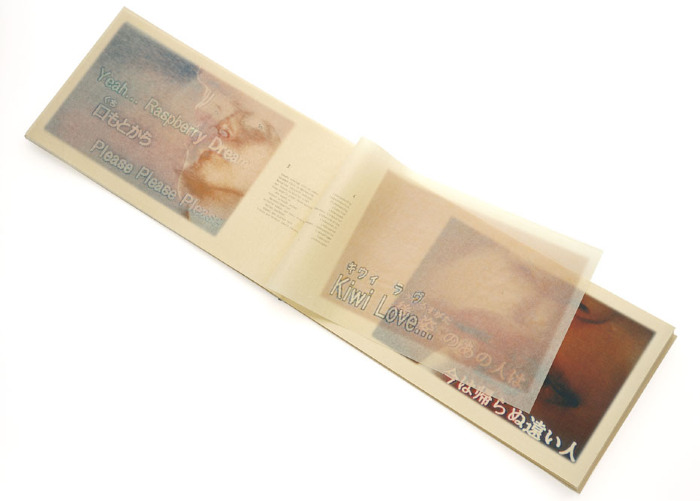von Liebeskunst und Liebesliedern
von Liebeskunst und Liebesliedern
Date
2000
Edition Size
20
Media
Photo
Paper
Mitsumata
Binding
Accordion
Format
Artist Book
Collection
Limited Edition Artists Books$ 1,800.00
Unavailable
View Collectors
Deutsche Nationalbibliothek
The University of the Witwatersrand, Wits Art Museum (WAM), Jack Ginsberg Centre for Book Arts
University of California, Los Angeles (UCLA), William Andrews Clark Library
University of California, Santa Barbara (UCSB)
Williams College, Chapin Library of Rare Books
In this book, Schäpers combines Helmut Heissenbüttel’s text Von Liebeskunst (The Art of Loving) with quotations from Japanese love songs, which were photographed from a Karaoke screen.
“Heissenbüttel’s text consists of quotations, images, and metaphors, which originate from all levels of literature – from classic to trivial. The names of the original authors are followed by thirteen chapters about love, like variations upon a theme in music. All of them focus in a shrill way on love; in chapter 6 for example, there are 39 different expressions for making love.
The quotations, printed in gray in the middle of each double-page, are framed by photographs, on which the texts of Japanese love songs appear. These songs do not only mix different language levels (similar to Heissenbüttel), but also different languages. All of the songs are “Japanese”, however, they often have an English refrain, because love is the topic.
To express the speed at which pictures on the screen move, I assemble always two photos for one chapter, using various mitsumata papers, i.e. gasen (a thick Japanese paper, which is normally used for calligraphy) and hakuai (a very thin paper, which normally serves as a backing for gold-leaf). When two photos are arranged one above the other, they fuse into a single picture.
Because of the sequences, one should be able to see the text as well as the pictures in a row. Hence, I made this book accordion fold. At the back, the pages are connected to the cover with graphite bars. If you take these bars out, you can perceive the book in its total length. On the cover are Japanese characters saying “I love you”, also photographed from the Karaoke screen. Interesting enough, in the context of Karaoke, the words are not the native Japanese expression (ai shite iru) nor the western alphabet, but the English “I love you” in Japanese writing.” — Veronika Schäpers




